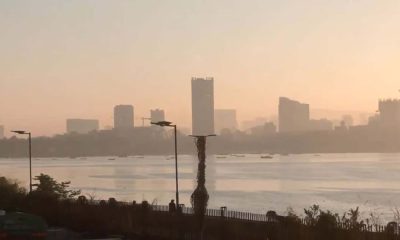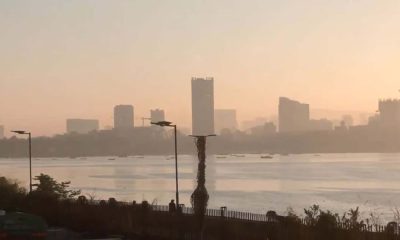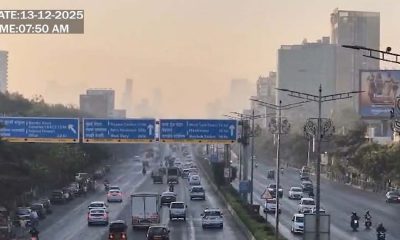Maharashtra
Maharashtra has 35K bridges and their upkeep poses nightmarish challenge
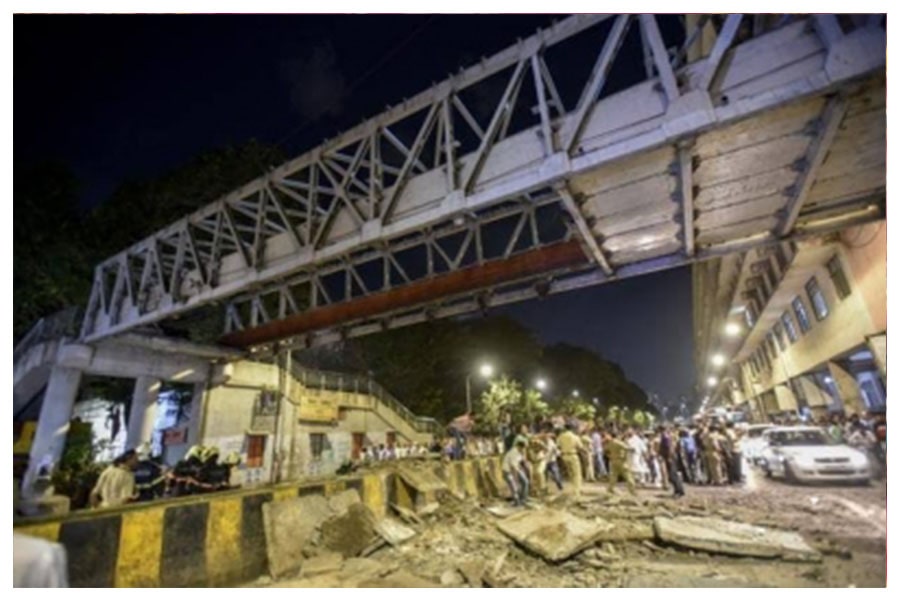
Maharashtra has a stupendous 35,000-plus big and small bridges on roads in village, towns, cities, state or national highways, posing mind-boggling challenges for their regular upkeep and maintenance, with multiple agencies involved, but recording barely 100 structures crashing since 2000, top officials said.
As per government data, under the state’s Public Works Department (PWD) jurisdiction, there are 146 small, 105 big and five long bridges (total 256) from the pre-Independence era, some dating back to over 350 years and still functional.
In the post-Independence era, the state recorded massive development since 1957, with around 16,000 small, 2100 big and 100 long (total 18,200) bridges being constructed.
Besides, there are some 12,000, including 2,000 major bridges, on the national highways crisscrossing the state, an estimated 4,000 (total 16,000) in various civic bodies’ jurisdictions, like some 450-odd in Mumbai, not counting another huge number of bridges on the railway networks.
Despite the huge numbers of bridges, in the past 22 years, barely around 100 medium or small have crashed – 75 percent of them comprising masonry design and the rest raft design – in different parts of the state.
The worst crash was the washout of 106-year-old British-era masonry bridge on the heavily-flooded Savitri River near Mahad in Ratnagiri on August 2, 2016, which swept away two ST buses and around 10 other private vehicles with the death toll touching 40.
There have been other smaller crashes in Mumbai and other parts of the state in the past two decades though with lesser casualties or fatalities.
As per Indian Road Congress (IRC) norms, a “small bridge” spans 06-60 metres, a “big bridge” is 60-200 metres and a “long bridge” is 200 metres plus and can go upto a few kms in length, each posing unique challenges for their upkeep and safety.
These bridges comprise a variety of designs, architecture styles and materials depending on their location, whether linking hills, mountains, passing over rivers, streams, drains (nullah), creeks, the sea (the Rajiv Gandhi Bandra Worli Sea Link or the upcoming Mumbai Trans Harbour Link), flyovers, road over-bridge, foot over-bridge, etc.
“There are prescribed SOPs for checks, routine, pre-monsoon and post-monsoon maintenance for all bridges, but with a staff of around 5,000, its possible to cover only around 35 per cent of the bridges in a year,” revealed a senior PWD officer, requesting anonymity.
As per the SOPs, any initial complaints go to the concerned local PWD office which sends out teams to inspect, and if there are serious problems, specialised team with experts from within and outside (like IITs, IIE, etc.) examine it scientifically, said the officer, who has personally inspected around 1,000 bridges in the past two decades in some of the most hazardous terrain.
Then, the cumbersome work of making reports, proposals, budget estimates, sourcing the funds, setting the time-frame, etc, takes place, and again depending on the urgency of the work, it may or may not be prioritised as paucity of finance remains the biggest hurdle.
A former PWD Chief Engineer of Bridges had suggested to the state government and Union Minister for Roads & Highways Nitin Gadkari to rope in the 30,000 students from civil engineering colleges studying in their two final years to help in the inspection works.
“They can form a part of the local PWD inspection teams and theoretically can inspect all the 35,000-bridges in the state in just a couple of days. This exercise can be done twice a year to reveal all the maintenance flaws and potential risks to any structure,” he said.
The students would be guided by the PWD experts, and it would have proved an invaluable academic field exercise with some incentives like grace marks or extra grades in their exams, etc, but there was no movement on his suggestion, rued the ex-CE.
Prescribing a regular “good health check-up” for all bridges, especially the old ones, a senior Highway Department officer appreciated the Indian Railways for their “constant vigil and dedicated teams carrying out daily, weekly, monthly inspections or biannual surveys of all their bridges” to ensure safety of the hundreds of trains hurtling around the country with passengers and cargo.
“Unfortunately, this zest is severely lacking among the states’ PWDs and virtually non-existent for the national highways authority, though the local civic bodies barely pass out on this count,” the officer said.
Touching on the Savitri River bridge crash, the PWD officer said it was nicknamed a “green bridge” as its fa�ade was completely covered with shrubs, bushes, creepers and small plants – but spelling a “red alert” from the safety aspect.
“Such overgrowth is rarely taken into account, another lurking danger is the dredging of sand from the water-bed in the vicinity, blatantly violating norms which weaken the bridge foundations and make it prone to a crash, overloading during peak hours which hasten the wear-and-tear, allowing vehicles to ply even when the flood levels touch or cross the red level marks, as it happened in the Savitri River case,” he said.
Officers from the Highways Department, PWD, civic bodies and others ruled that “unless regular inspection and maintenance” is carried out for all bridges – majority are already over 40-50 years old – there can be repetitions of the recent Morbi (141 dead) or the 2003 Daman & Diu (26 dead) type tragedies, with more risks added as new bridges come up practically every month in the massive expansion of the roads and railways in the country.
The inspection tasks are now considerably easier with the applications of computers, drones, satellites or other modern gadgets to scan the bridge health without physical presence, though the latest technological advancements come at a high price and are deployed on hardly one percent of all the structures in the state, the officials said.
Maharashtra
Ahead of BMC Polls 2026, Eknath Shinde Rallies Shiv Sainiks Across North Mumbai, Calls for United Push
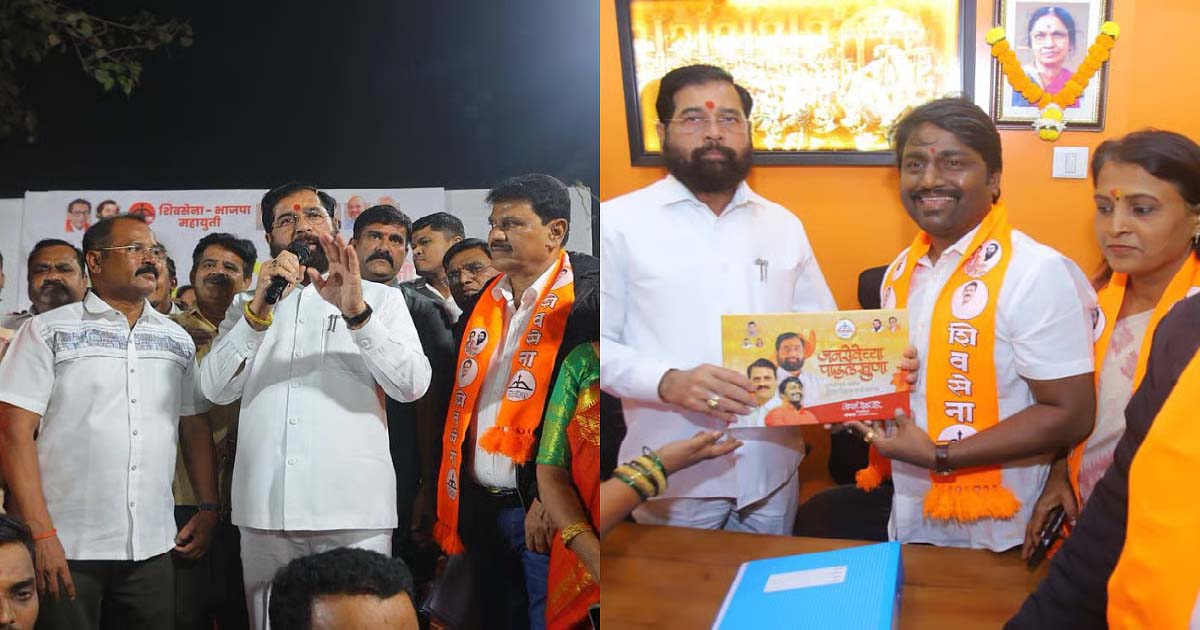
With the Brihanmumbai Municipal Corporation elections gathering momentum, Maharashtra Deputy Chief Minister Eknath Shinde on Wednesday intensified grassroots outreach by visiting several Shiv Sena branches across North Mumbai. Shinde interacted with party workers in Dahisar, Borivali, Kandivali, Malad and Magathane, urging unity and aggressive mobilisation ahead of the civic polls scheduled for January 15.
Referring to the announcement of the municipal elections, Shinde said the political atmosphere in Mumbai had clearly heated up. Using a colloquial metaphor, he remarked that the betel nut had been split and the wedding rush had begun, signalling that the real political contest was now underway.
He appealed to Shiv Sainiks to work together with discipline and commitment to ensure the saffron flag is hoisted over the civic body. Stressing organisational strength, Shinde said the coming weeks would be crucial in determining who controls the country’s richest municipal corporation.
During his interactions, Shinde highlighted the development work carried out during his two and a half year tenure as Chief Minister, followed by initiatives taken under Chief Minister Devendra Fadnavis and the Mahayuti government. He said citizens of Mumbai were aware of the scale of work undertaken across the city during this period.
According to Shinde, key civic issues such as housing, redevelopment, infrastructure and basic amenities remain at the top of the government’s agenda. He said the government has taken several important decisions to fulfil the dream of home ownership for citizens.
Shinde specifically referred to initiatives aimed at creating a slum free Mumbai, resolving long pending concerns of residents living in and around the Sanjay Gandhi National Park, and accelerating redevelopment of old and dilapidated settlements. These measures, he said, reflect the government’s commitment to inclusive urban development.
Reiterating confidence in the ruling alliance, Shinde said the Mahayuti government has been functioning capably across the state and expressed optimism that it would return to power in the civic body as well. He described the alliance’s vision as a double engine government that would now develop Mumbai at the speed of a triple engine.
Appealing to party workers, Shinde called for a massive victory on January 15 and said celebrations should follow the declaration of results the next day.
Several party leaders, including MLA Prakash Surve, Yuva Sena core committee member Raj Surve, Shiv Sena spokesperson Sheetal Mhatre, division chief Swapnil Tambwekar and local office bearers, were present during the interactions.
Maharashtra
Mumbai Weather Update For Dec 18, 2025: City Wakes To Winter Chill, But Smog Keeps Air Quality In Unhealthy Zone At 254
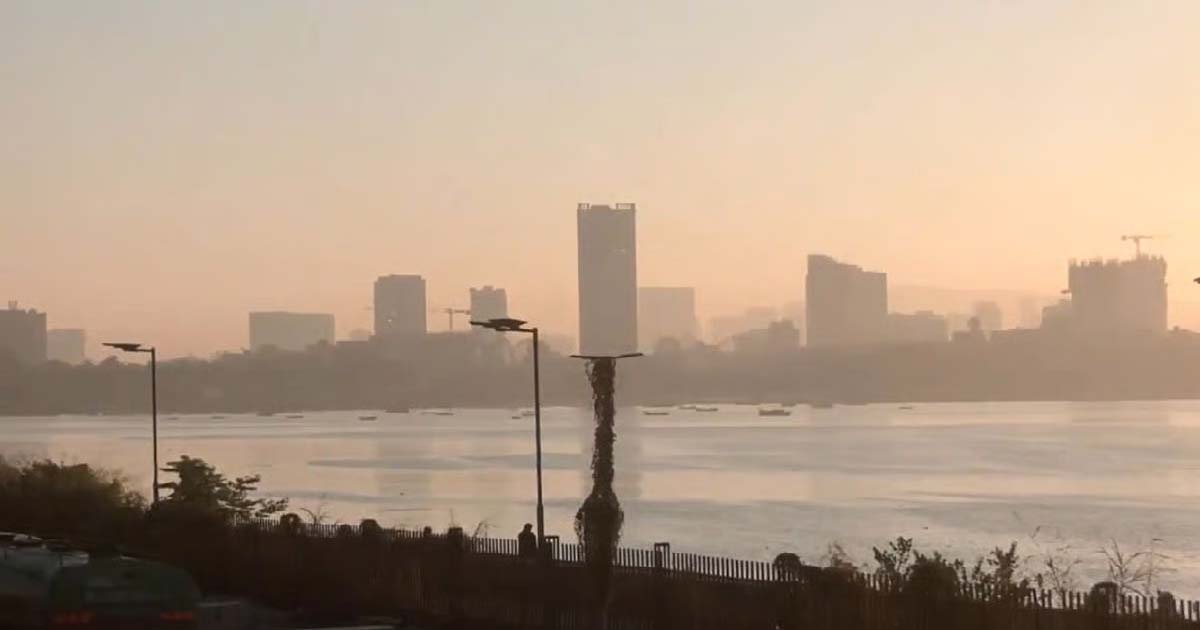
Mumbai: Mumbai began Thursday on a relatively cool and crisp note, offering residents a brief glimpse of winter-like comfort. Clear skies, light winds and lower humidity made for a pleasant early morning. However, the relief was short-lived as a visible layer of smog soon settled over the city, reducing visibility and once again underscoring Mumbai’s worsening air pollution crisis.
Despite favourable weather conditions forecast by the India Meteorological Department (IMD), air quality quickly emerged as the city’s biggest concern. The IMD had predicted a bright and comfortable day, with temperatures expected to hover between 17°C and 34°C. Yet, commuters, morning walkers and schoolchildren stepping out early were greeted by hazy surroundings and an acrid smell in the air, particularly in traffic-heavy corridors and low-lying areas.
According to data from air quality monitoring platform AQI.in, Mumbai’s overall Air Quality Index (AQI) stood at 254 during the early hours, placing it in the ‘unhealthy’ category. After showing signs of improvement over the past few weeks, pollution levels have once again deteriorated. Such AQI levels pose health risks to all residents, with children, senior citizens and those suffering from respiratory or cardiac ailments being especially vulnerable.
The renewed spike in pollution is largely being attributed to construction dust and fine particulate matter. Massive government-led infrastructure projects, including metro rail corridors, flyovers, coastal road extensions and extensive road-widening works, continue across the city. These, coupled with aggressive private real estate development, are releasing large volumes of dust into the atmosphere. Vehicular emissions during peak traffic hours are further compounding the problem, especially at key junctions.
Several areas emerged as major pollution hotspots. The Wadala Truck Terminal recorded a worrying AQI of 407, categorised as ‘hazardous’, indicating conditions that can seriously impact even healthy individuals. Chembur and Colaba followed with AQI readings of 328 and 318, respectively, both falling in the ‘severe’ category. Sion registered an AQI of 317, while Worli, a prominent commercial and residential hub, recorded 308.
Suburban areas fared marginally better, though pollution remained widespread. Kandivali East logged an AQI of 107 and Goregaon East stood at 130, both categorised as ‘poor’. Other areas such as Parel-Bhoiwada (153), Borivali West (177) and Charkop (187) also slipped into the poor range, reflecting the citywide spread of pollution.
For context, AQI levels between 0–50 are considered good, 51–100 moderate, 101–150 poor, 151–200 unhealthy and anything above 200 hazardous. With large parts of Mumbai hovering at or above unhealthy levels, concerns are growing over the long-term health implications as winter progresses and pollution episodes become more frequent.
Maharashtra
BMC elections announced but Mahayoti and Maha Vikas Aghadi clash over electoral pact

Mumbai: The Mumbai Municipal Corporation elections have been called but the political parties have not yet reached an electoral agreement. The Maha Vikas Aghadi and Mahayoti have started holding meetings regarding the electoral agreement, but despite this, no conclusion has been reached by all the parties, due to which the electoral agreement of the political parties in the BMC elections is still pending. The Uddhav Thackeray government fell in the Maharashtra Assembly in 2022 and now Uddhav Thackeray’s power has decreased and only 20 MLAs of Uddhav Thackeray have won, while Shinde Sena and BJP have maintained their power. The Mumbai Municipal Corporation elections have been announced and on January 15, the people will exercise their democratic right and the votes will be counted on the 16th and an announcement will be made on the same day. A round of meetings is underway between Shinde Sena and BJP regarding the electoral understanding and seat sharing, but so far they have not reached any conclusion. An understanding has not been reached between BJP and Shinde Sena regarding the Mahim, Parel, Dadar Byculla, and Kalabha areas because these areas contain a Marathi population along with Uttar Bharatiya. Both parties have claimed these areas. Due to organizational issues, Shinde Sena has claimed these areas and has said that due to organizational stability, these areas should be given to Shiv Sena. BJP voters have increased in the last election. BJP’s strength has increased here due to businessmen and Hindutva voters. Therefore, now the possibility of an electoral alliance at the local level is clear, while the alliance is still pending in Maha Vikas Aghadi because due to the alliance between Uddhav Thackeray and Raj Thackeray, Congress and NCP have not yet taken any decision on the electoral alliance. In such a situation, if there is no electoral alliance in Maha Vikas Aghadi and Mahayoti in BMC, then this contest will be more interesting because in this election, two Shiv Sena, two NCP and other parties will try their luck and the number of candidates entering the electoral fray will also increase.
-

 Crime3 years ago
Crime3 years agoClass 10 student jumps to death in Jaipur
-

 Maharashtra1 year ago
Maharashtra1 year agoMumbai Local Train Update: Central Railway’s New Timetable Comes Into Effect; Check Full List Of Revised Timings & Stations
-

 Maharashtra1 year ago
Maharashtra1 year agoMumbai To Go Toll-Free Tonight! Maharashtra Govt Announces Complete Toll Waiver For Light Motor Vehicles At All 5 Entry Points Of City
-

 Maharashtra1 year ago
Maharashtra1 year agoFalse photo of Imtiaz Jaleel’s rally, exposing the fooling conspiracy
-

 National News1 year ago
National News1 year agoMinistry of Railways rolls out Special Drive 4.0 with focus on digitisation, cleanliness, inclusiveness and grievance redressal
-

 Maharashtra1 year ago
Maharashtra1 year agoMaharashtra Elections 2024: Mumbai Metro & BEST Services Extended Till Midnight On Voting Day
-

 National News1 year ago
National News1 year agoJ&K: 4 Jawans Killed, 28 Injured After Bus Carrying BSF Personnel For Poll Duty Falls Into Gorge In Budgam; Terrifying Visuals Surface
-

 Crime1 year ago
Crime1 year agoBaba Siddique Murder: Mumbai Police Unable To Get Lawrence Bishnoi Custody Due To Home Ministry Order, Says Report





